In recent years, some SEO influencers have openly shared their use of black hat tactics on YouTube and X. These individuals have gained significant followers by showcasing screenshots of their traffic growth.
However, boasting about such tactics can lead to severe consequences. If you engage in shady practices, it’s best not to showcase them because the risks are high.
Many who have bragged about unethical strategies have faced severe penalties, such as getting their websites de-indexed by Google, which means their websites that once attracted hundreds of thousands or even millions of visitors per month saw their traffic drop to zero.
In this article, we’ll explore the dangers of black hat SEO and provide insights into 10 specific techniques you should avoid.
4 Dangers of Black Hat SEO Methods
Black hat SEO refers to unethical practices used to manipulate search engine rankings. These techniques go against search engine guidelines and aim to deceive search engines and users.
Black hat SEO techniques might seem tempting for their promise of quick gains, but they come with significant risks. The truth is, if you’re reading about a black hat technique, it likely no longer works.
Search engine algorithms are trained to recognize many common black hat techniques — like private blog networks, for instance — and the pages that use them are ignored or penalized.
Here are four major dangers of using black hat SEO methods.
1. Damage to Site Reputation and Loss of User Trust
Search engines penalize sites using black hat SEO, often resulting in de-indexing. When a site is de-indexed, it disappears from search engine results pages, causing a severe drop in traffic. Rebuilding credibility after such a penalty is challenging and time-consuming.
Black hat SEO practices often mislead users, creating a poor experience. When users realize they’ve been deceived, they are likely to abandon the site and avoid it in the future. This loss of trust can significantly damage a brand’s reputation and reduce long-term user engagement.
2. Legal Implications
Some black hat practices, such as content scraping and buying links, can lead to legal issues. Content scraping involves copying content from other websites without permission, violating copyright laws.
Buying links often breaches the terms of service of search engines and can result in lawsuits and fines. These legal problems not only drain financial resources but also further tarnish a site’s reputation. Stick to ethical or white hat SEO techniques to avoid these costly and damaging legal repercussions.
3. Algorithm Updates
Search engines frequently update their algorithms to combat black hat SEO tactics. These updates can drastically affect the rankings of sites using such methods. A site relying on private link networks, for example, might see its rankings plummet after an algorithm update targets this tactic.
For a real-world illustration, here’s data from May 2024 showing websites with the greatest percentage declines in SEO visibility after Google’s recent core updates:
Staying compliant with SEO best practices is vital to avoid being negatively impacted by these updates. Relying on black hat methods puts a site at constant risk of being hit hard by these inevitable changes.
4. Short-Term Gains, Long-Term Losses
While black hat SEO methods might offer quick boosts in traffic and rankings, they are not sustainable. Over time, the risks and penalties associated with these tactics outweigh the short-term benefits.
Sites relying on black hat SEO often find themselves constantly rebuilding their presence from scratch after penalties. This cycle of gain and loss is not only exhausting but also detrimental to long-term growth.
Focusing on white hat SEO strategies builds a stable, reliable foundation that supports sustained growth and success:
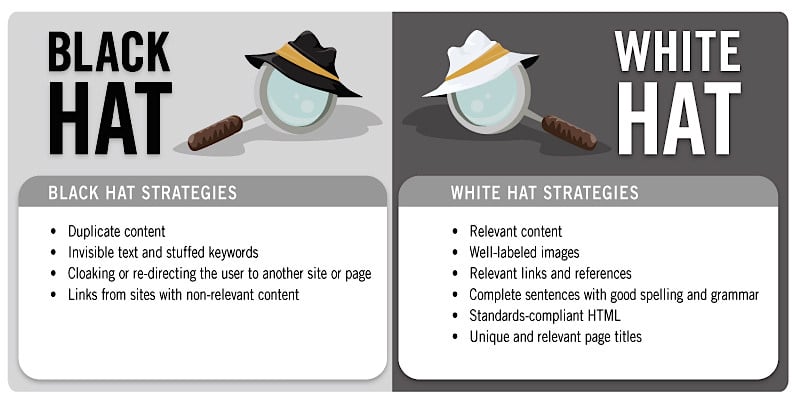
Key Takeaway: While black hat SEO methods (or even grey hat SEO tactics) may seem appealing for their quick results, the dangers they pose far outweigh the benefits. To build a successful, sustainable online presence, it’s crucial to adhere to ethical SEO practices and focus on creating high-quality content that meets users’ needs.
10 Black Hat SEO Techniques to Avoid
Not all tactics are created equal in the world of SEO. While black hat SEO techniques might promise quick gains, they come with significant risks and often result in penalties.
We’re listing these techniques here as a warning of what won’t work in the long run. Avoid these 10 black hat SEO methods to ensure your site remains trustworthy and compliant with Google’s guidelines.
Tactic #1. Keyword Stuffing
The oldest trick in the book. Keyword stuffing involves overloading a web page with keywords in an unnatural manner to manipulate search rankings. This technique disrupts the flow of content, making it difficult for users to read and understand.
Search engine crawlers have become adept at detecting keyword stuffing and will penalize sites that engage in this practice, reducing their visibility in search results.
Example: A page about dog training might repetitively use the phrase “best dog training tips” in every sentence: “The best dog training tips can be found in our guide on best dog training tips. For the best dog training tips, visit our best dog training tips page.”
How to Avoid This
Focus on creating high-quality, natural content that provides value to your readers. Use keywords strategically by incorporating them naturally within your content.
Aim for a keyword density of around 1-2% and ensure that the content reads smoothly. Use synonyms and related terms to avoid repetition and improve readability. Tools like Yoast SEO can help you monitor and optimize keyword usage without overdoing it.
Tactic #2. Cloaking
Cloaking is a deceptive technique where different content is shown to search engines and users. For example, a webpage might present keyword-rich content to a search engine while showing irrelevant or spammy content to users.
This SEO tactic violates Google’s webmaster guidelines and can result in severe penalties, including de-indexing of the site:
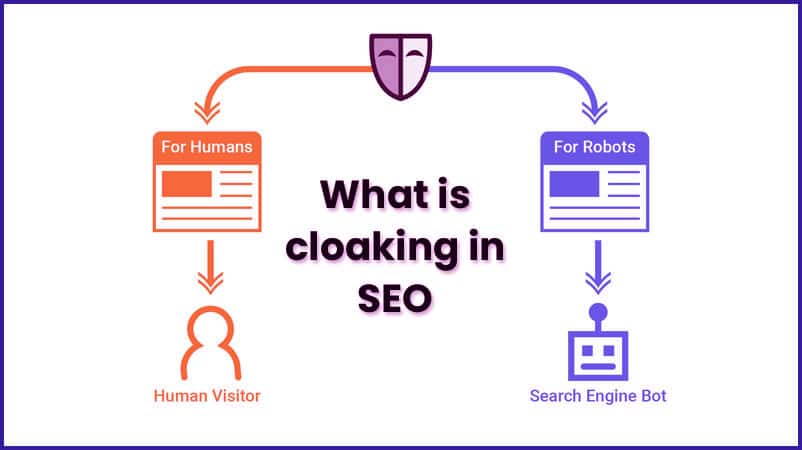
Example: A website might show search engines a page full of keywords related to “cheap flights,” but users who visit the page might see ads for unrelated products like weight loss pills.
How to Avoid This
Ensure that the content you present to search engines is the same content that users see. Focus on providing valuable, relevant content for your target audience.
Regularly review your website to ensure there are no discrepancies between what search engines and users see. Tools like Google Search Console can help you monitor your site’s performance and detect any issues with how your content is presented.
Tactic #3. Invisible Text
Invisible text involves hiding text on a webpage by making it the same color as the background. This hidden text often contains keywords meant to game search engine algorithms.
While users can’t see this text, search engines can detect it and will penalize sites that use this black hat SEO tactic, as it violates the principle of providing transparent, user-focused content.
Example: A webpage might have a white background and include a block of white text at the bottom filled with keywords like “buy shoes online,” “cheap shoes,” and “best shoe store.”
How to Avoid This
Always ensure that all text on your website is visible and readable to users. Use keywords naturally within your content without attempting to hide them.
Regularly audit your website for any hidden text and remove it immediately. Focus on creating high-quality content that naturally incorporates keywords in a way that benefits your readers.
Tactic #4. Link Farms
Link farms are networks of websites created solely to increase the number of backlinks to a target site. These backlinks are often low-quality and irrelevant:

Search engines value quality over quantity when it comes to backlinks, and using link farms can result in severe penalties. Genuine, organic backlinks are far more effective for improving search rankings.
Example: A link farm might consist of dozens of poorly designed websites, each linking to the same target site with generic phrases like “click here” or “visit this site,” with no real context.
How to Avoid This
Focus on earning high-quality, organic backlinks from reputable websites. Create valuable content that others will naturally want to link to. Check out our guide to link building content for SEO to learn more.
Engage in genuine outreach to build relationships with other site owners and influencers in your niche, and avoid any services or offers that promise a large number of backlinks quickly, as these are often associated with link farms.
Tactic #5. Doorway Pages
Doorway pages are low-quality pages stuffed with keywords that redirect users to another site. These pages provide little to no value to users and are created solely to manipulate search engine rankings:
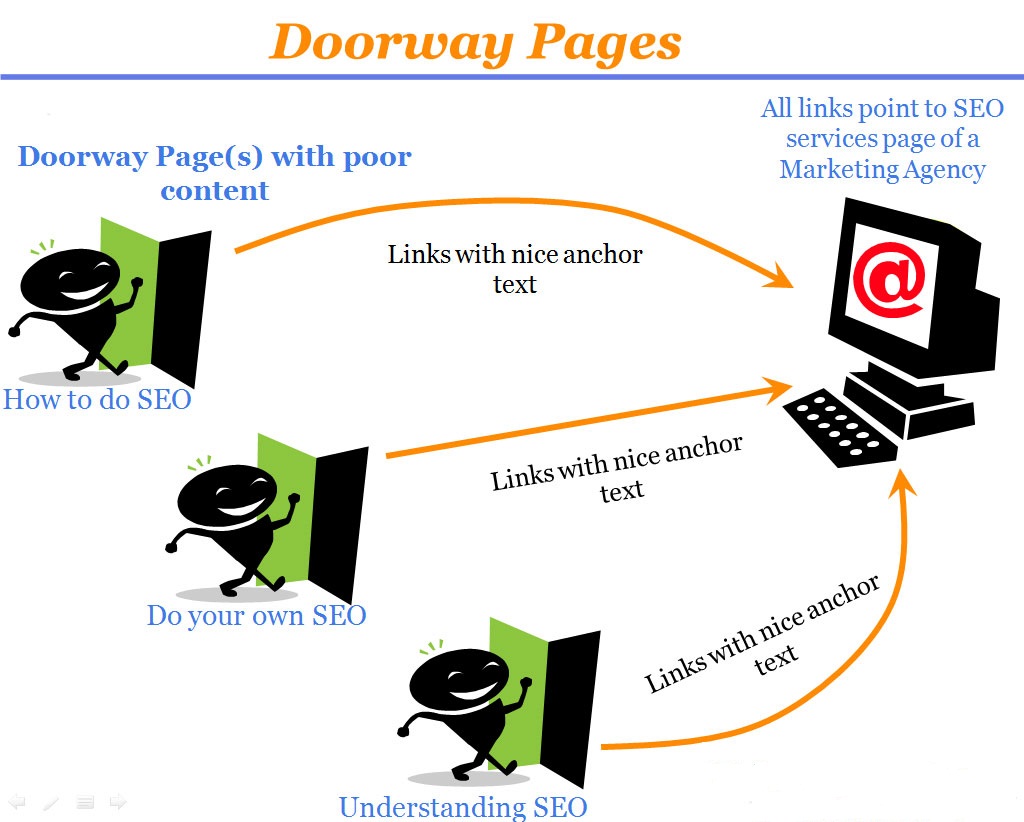
Search engines are proficient at identifying doorway pages and will penalize sites that use them, harming their overall search visibility.
Example: A doorway page might be filled with keywords about “best travel deals” but instantly redirects users to an unrelated e-commerce site when they click on the link.
How to Avoid This
Ensure that each page on your website provides unique, valuable content relevant to the keywords it targets. Avoid creating pages solely for the purpose of redirecting users.
Focus on enhancing the user experience by providing relevant and useful content on all your pages. If you need to redirect a page, use 301 redirects for legitimate reasons, such as moving to a new URL:

Tactic #6. Content Scraping
Content scraping involves copying content from other websites without permission and republishing it as your own:
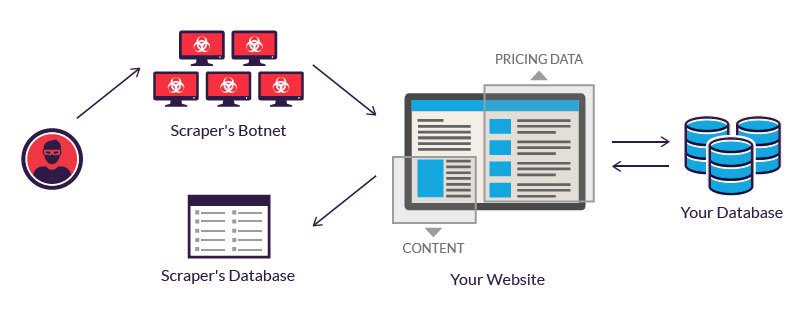
This practice not only violates copyright laws but also provides no original value to users. Search engines prioritize original content and will penalize sites that use scraped content, reducing their rankings and credibility on search results pages.
Example: A blog might take entire articles from other well-known websites and post them without any modification or attribution, trying to pass them off as original content.
How to Avoid This
Create your own original content. Research topics thoroughly and present information in your own words, providing unique insights and perspectives.
If you must reference other content, always give proper credit and use quotations or citations. Tools like Copyscape can help ensure your content is original and not inadvertently similar to existing works.
Tactic #7. Article Spinning
Article spinning uses software to rephrase existing articles to create “new” content quickly. This spun content is often of low quality and can be difficult for users to read.
Search engines recognize spun content and penalize sites that use it, favoring site owners who create original, high-quality content that genuinely benefits users.
Example: An article about “How to Train Your Dog” might be spun to read “Ways to Educate Your Canine” with awkward and unnatural phrasing that makes the text hard to follow.
How to Avoid This
Focus on writing original content that provides value to your readers. Invest time in researching and creating high-quality articles instead of trying to produce a large volume of low-quality content.
Avoid using article spinning software. Engage with your audience to understand their needs and preferences, and create content that addresses those specifically.
Tactic #8. Paid Links
Buying or selling links to boost a site’s ranking is against search engine guidelines. Paid links are often low-quality and irrelevant, and search engines can detect unnatural link patterns.
Sites that engage in this practice risk severe penalties, including significant drops in search rankings and de-indexing.
Example: A website might pay another site to include a link to their page with a phrase like “best online casino” embedded in a random article that has nothing to do with gambling.
How to Avoid This
Focus on earning links naturally by creating high-quality content that others want to link to. Engage in legitimate outreach to build relationships and earn backlinks from reputable sources.
Avoid any services that promise a large number of backlinks quickly, as these often involve paid links. Use tools like Google Search Console to monitor your backlink profile and ensure it remains healthy and organic.
Tactic #9. Blog Comment Spam
Comment spam involves posting irrelevant comments on blogs and forums with links to your website. This tactic not only annoys users but also provides little to no SEO benefit. Search engines can detect and disregard spammy links, and sites that use this method risk being penalized for trying to manipulate rankings through spam.
Example: A blog post about cooking might have a comment that says, “Great article! Check out my website for cheap electronics [link],” which is irrelevant to the topic of the blog.
How to Avoid This
Engage genuinely in online communities by providing valuable, relevant comments and contributions. Only include links when they add real value to the conversation:
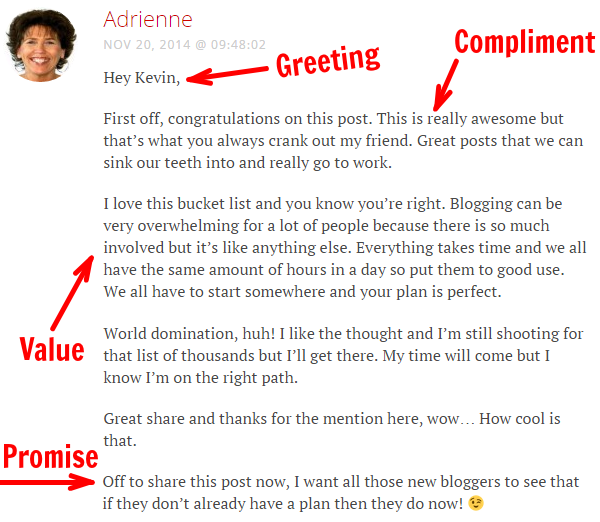
Build relationships with bloggers and forum moderators to earn legitimate backlinks. Focus on contributing to discussions in a meaningful way that enhances your credibility and authority.
Tactic #10. Clickbait
Clickbait uses misleading titles and descriptions to attract clicks and increase traffic. While this might temporarily boost traffic, it creates a poor user experience and damages trust:

Users quickly realize they’ve been misled and are likely to leave the site immediately. Search engines aim to provide users with relevant and accurate content, and they will penalize sites that frequently use clickbait tactics.
Example: An article titled “You Won’t Believe What Happened Next!” might lead to a mundane story about everyday activities, frustrating users who expected something extraordinary.
How to Avoid This
Use accurate and descriptive titles that clearly reflect the content of your articles. Aim to attract readers by providing high-quality, relevant content that meets their expectations.
Build trust with your audience by consistently delivering on your promises. Regularly review your titles and descriptions to ensure they are honest and engaging without being misleading.
Key Takeaway: By avoiding these black hat SEO techniques, you can build a sustainable, trustworthy online presence that complies with search engine guidelines and provides genuine value to users.
Last Thoughts on the Risks of Black Hat SEO
In the end, black hat SEO might seem like a quick way to get ahead, but it’s a dangerous game with serious consequences. From damaging your site’s reputation to losing user trust, the risks far outweigh any short-term benefits.
Think of your website as a long-term investment. Just like you wouldn’t cut corners with your health or finances, you shouldn’t do it with your SEO either. Building a strong, trustworthy online presence takes time and effort, but it pays off in the long run.
Play it safe and smart. Stick to white hat SEO tactics that align with search engine guidelines and prioritize your users’ experience. Focus on creating high-quality content that genuinely helps your audience. It might take a bit longer to see results, but the steady, sustainable growth you achieve will be well worth the wait.
Remember, in the world of SEO, slow and steady truly wins the race!
Related Video
Ready to level up your SEO game? Single Grain’s SEO masterminds can help!👇
For more insights and lessons about marketing, check out our Marketing School podcast on YouTube.




